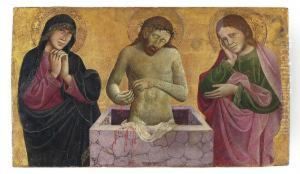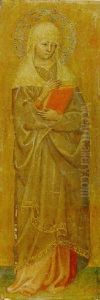Michele Di Matteo Da Bologna Paintings
Michele di Matteo da Bologna, also known as Michele di Matteo Lambertini, was an Italian painter and illuminator active during the Renaissance period. While his exact birth date remains unknown, historical records indicate that his artistic activity was primarily concentrated in the mid-15th century.
Michele di Matteo was primarily based in Bologna, which was a significant center of art and learning during the Renaissance. His work reflects the influence of the early Renaissance artistic developments that were emerging from Florence and spreading throughout Italy. Although not as widely known as some of his contemporaries, Michele di Matteo contributed to the artistic landscape with his own distinctive style.
He was primarily known for his religious works, which included altarpieces, frescoes, and manuscript illuminations. His style was characterized by a graceful use of line and a delicate approach to figures, which he often portrayed with gentle expressions and soft, flowing draperies. Michele’s work suggests that he was aware of the advances made by the likes of Masaccio and Fra Angelico, and he sought to incorporate a sense of depth and volume into his own compositions.
One of his most significant works is the altarpiece 'Madonna with Child Enthroned', which was originally created for the church of San Procolo in Bologna and is now housed in the Pinacoteca Nazionale di Bologna. This piece is emblematic of his ability to blend the Gothic and Renaissance styles, showing a clear transition that many artists of the time were undergoing.
Michele di Matteo’s contributions to manuscript illumination also mark him as a significant figure in the history of the illustrated book. He produced illuminations for various religious texts, infusing them with the same sense of elegance and serenity found in his panel paintings.
Unfortunately, Michele di Matteo’s life and works have not been as thoroughly documented as some of his peers, resulting in a somewhat obscure historical profile. He is believed to have died in 1469, leaving behind a body of work that, while not extensive, provides valuable insights into the artistic transitions of 15th-century Italy and the local characteristics of Bologna’s Renaissance art.







